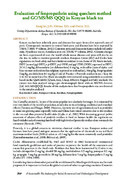| dc.description.abstract | Kenyan tea has been relatively pests and diseases free apart from a few reported cases of
pests. Consequently measures to control both pests and diseases have been reported by
TRFK (TRFK 5th edition, 2002). Common pests and diseases in Kenya include red spider
mite, Nyambene weevil, Armillaria root rot (TRFK 5th edition, 2002). Climatic changes
are been experienced all over the world which means diseases and pests will also be on
the rise. In order to monitor pesticide residues, European Union (EU) and Codex have
regulations on food safety and have limits on residues in tea. Some of EU limits include;
DDT (sum of p,p'-DDT, o,p'-DDT, p-p'-DDE and p,p'-TDE (DDD) expressed as DDT)
(F) 0.2 mg/kg, deltamethrin (cis-deltamethrin) 5 mg/kg, endosulfan (sum of alpha- and
beta-isomers and endosulfan-sulphate expressed as endosulfan), 30mg/kg, Fenpropathrin
2mg/kg, methidathion 0.1 mg/kg (Code of Practice – Pesticide residues in tea / Issue 16,
2/4 /12) to name but a few. Black tea samples were extracted using acetonitrile as a solvent based on the QuEChERS (Quick, Easy, Cheap, Effective Rugged and Safe) method. The extract was then analysed using a gas chromatograph fitted with an MS/MS detector (GC-MS/MS QQQ). Results of this analysis show that fenopropathrin was not detected in the samples analysed. | en_US |
